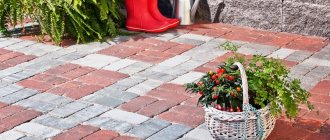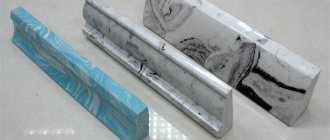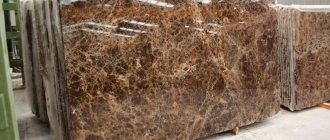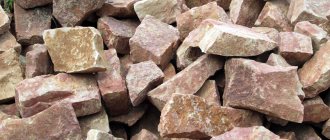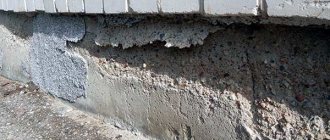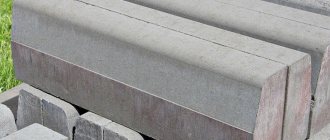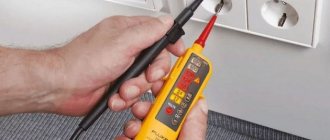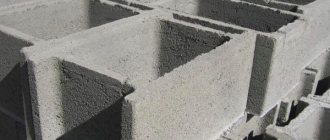Why do you need glue for stone?
The method of gluing stone and stone slabs is the most popular, and in terms of ease of implementation it is superior to other fastening methods. Previously, reinforcement was used much more often to work with marble and granite, which caused many difficulties.
Installation of granite tiles with glue
It is almost impossible to install reinforcing elements without damaging the stone. Installation of rods requires caution and attentiveness from the master, although it gives a good result in terms of strength.
Important! It is more convenient to work with glue, and the effectiveness of the technique will also be quite high.
Even when using reinforcement, additional sizing of the stone is recommended in order to increase the reliability of adhesion to the maximum level. Some craftsmen try to glue marble or granite onto ordinary cement mortar.
Fasteners for natural stone
This method of fastening is also not ideal - after a couple of years, the cement begins to crack, especially when it comes to exterior finishing. Only special adhesives contain special components that enhance elasticity and increase resistance to temperature changes. Some of them have the highest frost resistance, so they are suitable even for harsh climatic conditions.
Characteristics of marble adhesive
Adhesive for marble
For finishing various structures, slabs of marble or other natural stone are usually used. To attach it to the surface, you need an adhesive that can provide a strong connection. Absolutely all adhesives have frost resistance properties. They are used for making inlays and mosaics, processing seams and gluing elements of natural stone. Its main properties:
- resistance to ultraviolet rays, acids and alkalis;
- maintaining efficiency within temperatures from -20 to +100°C;
- after hardening, the composition does not change its color, does not shrink or crack;
- dries quite quickly, in 2-3 hours.
Tile adhesive can be:
- polyester;
- epoxy adhesive.
Polyester blends are available in solid, liquid or semi-liquid form. High-quality brands include the highly reliable composition Solido quarzo crema. This material is intended specifically for gluing natural stone. To use it, you need to mix it with a hardener of the Mastic 2000 brand. This version of the glue is most often used indoors for making mosaic panels, for gluing fragments of marble and granite.
The two-component epoxy-based stone adhesive is so strong that it can be very difficult to separate the glued piece from the surface. It consists directly of glue and hardener. The Akepox 1005 brand is of the highest quality. The composition is used to seal cracks in stone. Other compositions are durable, resistant to acids and solvents, and have excellent adhesion. Two-component compositions are used outdoors for cladding walls outside the building. They can glue the stone even to a surface with bumps and depressions.
Requirements for the adhesive composition
Different types of stone have different technical characteristics and operational parameters. For example, granite is very hard and weighs a lot, while limestone is looser; marble is quite dense and contains many different mineral components. In this regard, stone adhesive must be suitable specifically for a specific material, have the highest adhesion force to it, and penetrate deeply into the pores.
Other requirements that the glue must meet:
- The composition must be ideally suited for specific conditions of use or be universal. There must be permission to use it for external and internal work. Some products are applied to stone slabs for gluing to the surface, while others allow you to seal seams and restore chips in the stone. This point is important to consider when purchasing.
- If the adhesive is to be applied to external substrates, it is better that it can withstand any temperature without problems and can be used even in harsh conditions.
- Glue for granite or other stone must be durable and not be destroyed by chemicals, sunlight, or atmospheric moisture.
- Good glue lasts for many years, does not crack, does not lose its original properties, does not change its appearance, shape, color or texture.
- The hardening speed of the glue should be quite high. This will allow you to start using the product after a short time.
Adhesive for marble and granite for interior work
There are more favorable operating conditions indoors, so adhesive for marble and granite can be chosen without frost resistance requirements:
- Unis XXI glue is perfect for flooring, and the price is low: from 220 rubles. 25 kg.
- In the bathroom, kitchen, where there is usually high humidity, lay the floor using Unis 2000 marble and granite adhesive, specially designed for wet operating conditions; for walls, choose Unis Plus - with increased fixation.
- Knauf Flizen glue is also used for cladding floors and walls with natural stone; this universal adhesive will cost from 270 rubles.
Types of adhesives for stone
Depending on the composition, properties and conditions of use, stone adhesives are classified into several groups.
Polyester adhesives
This group includes liquid, semi-liquid, solid adhesives and mastics with one- and two-component composition. They are ideal for installing artificial stone slabs on any base, for interior mosaic finishing, porcelain tile cladding, repairing marble, onyx, granite and other stones. Adhesives are available in white and tinted forms, so they are suitable even for decorative purposes.
Important! All polyester adhesives have the property of thixotropy and can be applied even to vertical substrates; they are easy to apply and spread, and do not flow.
Akemi marble adhesive putty
In the hardened form, they are well sanded and polished. Adhesives with polyester practically do not shrink; some of them tolerate low temperatures, although they are not extremely frost-resistant.
Two-component epoxy compounds
Compositions based on epoxy resin are characterized by very high adhesion to most building materials, including natural and artificial stone. They are distinguished by their unsurpassed strength and ability to attach granite, marble, onyx and other materials to concrete, metal, and other bases no less reliably than reinforcement. Most compounds are also suitable for repairs, restoration, filling up chips and fastening stone elements together.
Epoxy adhesives are presented in the form of a base (epoxy resin) and a hardener, and the components are mixed together immediately before starting work. They easily tolerate sub-zero temperatures (down to -25...-35 degrees), heating up to +60 degrees, are suitable for indoor and outdoor use, and are resistant to ultraviolet radiation.
Epoxy adhesive for stone Akepox
Due to its moisture resistance, epoxy adhesive reliably protects facade seams from the penetration of moisture from the air and precipitation. With the use of epoxy adhesives, the appearance of efflorescence after the end of the winter season is excluded, and the stone will maintain its integrity throughout the entire period of operation.
Polyester adhesives
Adhesives and mastics based on polyester resin are most often used for interior work on stone, since they can withstand temperatures ranging from 0...+110 degrees without loss of properties. They cure very quickly (literally in 7 minutes), have high adhesion to surfaces, penetrate into the pores of the stone and reliably glue the slabs together.
Important! The compositions are ideal for the manufacture and repair of countertops, fireplaces, and sealing joints between slabs.
Liquid polyester adhesive for stone ILPA JOLLY
Impregnants
This is the name for adhesives that penetrate deeply into the porous structure of the stone due to the presence of special chemicals (resins, polymers) and high fluidity. They are frost-resistant and can easily withstand even sharp drops in temperature without losing their performance properties.
Impregnants strengthen the stone as they impregnate its smallest pores and cracks. They form a film on the surface that protects the base from chemical exposure, ultraviolet radiation, and moisture. After complete hardening, the adhesive joints can be sanded and polished.
Cement adhesives
One-component cement compositions are rarely used for laying stone pavements, since they do not provide the necessary strength and stability to the base. But for artificial marble you can purchase combined compositions with the addition of polyurethane, acrylic, and other polymer components. If the material will be used indoors, it can be glued to a porcelain tile compound, which provides high bond strength.
Subtleties of choosing adhesive for tiles
First of all, pay attention to how long the composition remains usable after you prepare it for application. Since marble is a very heavy material, working with tiles made from this stone is quite slow and takes a lot of time. If you buy glue that dries too quickly, you will either not have time to use it up, which is not profitable, or you will have to dilute it in very small portions, which will slow down your work even more. To avoid this, choose only products that remain usable for at least three hours.
To ensure that the marble tiles do not fall off after the glue dries, it must have sufficient adhesive properties. Choose a product that can withstand 80 kg of stone per square meter of area. This glue will tightly hold any marble tile, even the largest one.
Another important quality of stone glue is its frost resistance. The worse the product tolerates freezing, the sooner the marble tiles will begin to fall off. In order for the cladding to serve you for many years, you need to buy glue that can withstand at least 35 freezing cycles. Since temperatures can both fall and rise many times in one winter, products with fewer freezing cycles may lose their properties after just a few years, so you should avoid purchasing them.
Make sure that the glue you choose does not lose its properties when exposed to moisture and low temperatures. You should also refuse to purchase any products that may lose their properties when in contact with aggressive substances. These qualities of glue may not seem so important when facing interior spaces, but they should not be neglected. If there are interruptions in heating, the temperature inside the building can drop quite low, and low-quality glue will not be able to withstand this. In addition, any household chemicals may get on the tiles.
Due to seasonal temperature changes, even in heated rooms, marble tiles will periodically change their size slightly. To prevent it from losing its tightness due to this, the glue must have good plasticity, otherwise its contact with the material will gradually weaken and the tile will simply fall off.
Since marble is a material with a porous structure, the glue for it must be similar in color to the tile itself, otherwise it can ruin the appearance of the stone. If you cannot find the composition of a suitable shade, just buy a transparent one; it will not damage the aesthetic properties of the material, regardless of its color.
Each adhesive has a maximum allowable application thickness, sometimes indicated by the manufacturer on the packaging. If the surface you want to lay tiles on top has any unevenness, it can be very difficult to maintain the thickness of the application equally well throughout its entire length. This can become a hindrance if the adhesive you choose has a very small permissible application thickness: even a small mistake on your part can lead to the tile not sticking tightly.
Features of different types of glue
As is the case with other types of chemistry for natural stone, there are several different types of glue that differ from each other in their properties. First of all, it is worth considering cement-based compositions. Due to the ease of their manufacture, such products cost much less than other types of glue. To produce such compositions, white or gray cement of grades M400-M600 is used, which affects the color of the final product. This glue completely hardens 6 hours after dilution, which allows you to take your time when carrying out finishing work.
Another type of marble adhesive are those based on epoxy resin and polyurethane. They are much more elastic than cement products, due to which they have a much wider range of permissible temperatures. Such products are able to hold the tile firmly even when cement-based compounds begin to crack. In addition, such glue can be transparent. It requires great care when mixing its components, since in order to obtain a solution with the desired qualities it is necessary to strictly maintain their dosage. This glue does not allow moss and lichen to settle in the joints between the tiles, which will greatly simplify your care of the stone. The disadvantages of such products include their high price, as well as shorter drying time than cement-based compositions.
Choosing the right composition
Stone pavement made from natural materials is very heavy, and the adhesive composition for fixing it must have the highest adhesive qualities. On average, it should hold at least 80 kg of finish for every square meter of surface.
If work is carried out outside buildings, then the product must be resistant to low temperatures (at least 35 freezing and thawing cycles) and temperature changes, moisture, and ultraviolet radiation. The adhesive must have the ability to compensate for linear vibrations, otherwise during thermal expansion it may peel off from the finish or base.
Working with natural and artificial stone is quite difficult, especially for beginners. Therefore, it is better to choose an adhesive composition with a sufficiently long period of use after mixing or diluting. Otherwise, the product will remain unused and harden.
Important! The minimum period of its viability is approximately 3 hours.
There are a number of other recommendations that professionals give for the correct selection of adhesive:
- Polyester adhesives are well suited for marble, onyx, and travertine indoors. Mastics are chosen when you have to work with a vertical base or with quartz agglomerate.
- Granite cladding on the outside of buildings should be secured with two-component epoxy adhesive. The same composition will be ideal for installation and restoration of monuments.
- Horizontal bases inside the house are finished using cement-polymer compounds. For sandstone, inexpensive cement-based mixtures with various modifiers are suitable, but for limestone it is better to choose a composition with increased adhesion and strength.
- Polyester and vinylester mastics are suitable for various works on all types of stone, including repairing and sealing cracks, as well as for installing quartz ceramics.
Mastic adhesive based on polyester resin
How to choose
To choose the best adhesive product, you should take into account the characteristics of the material you will have to work with:
- natural stone is heavy, so for its reliable and high-quality fastening, use only a product with excellent adhesive properties;
- building facades are exposed to intense moisture and temperature changes; the product intended for their cladding must be resistant to such factors;
- the thermal expansion indicators of the cladding material and the base on which it is attached can vary significantly, for this reason the adhesive must compensate for fluctuations in linear dimensions;
- finishing is complicated by the edges present on the material (smooth and uneven), because of them, the facing work takes more time, for this reason the period of use of the finished solution should be long.
Advice! When choosing a product, be sure to read the instructions for working with it. When purchasing, give preference to manufacturers with a good reputation.
Selection rules:
- The minimum pot life of diluted glue should be 3 hours.
- The product must hold 1 m2 of stone weighing 80 kg.
- The composition must withstand at least 35 freeze-thaw cycles.
- For a granite monument, a two-component adhesive is best.
- Horizontal surfaces can be finished using a cement-based composition.
- For marble finishing, a two-component product or a cement-based product containing innovative additives is suitable.
- Sandstone can be fixed with inexpensive dry cement mixtures.
- For quartz slate, cement compositions of average cost are preferred.
- Limestone can be properly attached only with a diluted dry mixture with increased adhesion and strength.
The best brands of adhesives for stone
In hardware stores you can find a wide variety of compounds for working with stone surfaces. The most popular adhesives:
- "Knauf Flex" for porcelain stoneware and natural stone. Elastic tile composition for foundations with high deformation loads. Particularly suitable for surfaces subject to temperature fluctuations.
- AKEPOX 5010 AKEMI. Two-component epoxy composition, easily tinted, suitable for white and other materials. It cures completely in 16 hours, does not turn yellow from the sun, and does not shrink.
- STONEPOXY BELLINZONI. A product for gluing natural and artificial stone, resistant to alkalis, acids, and solvents.
- TITANIUM EXTRA CLEAR TENAX. Polyester mastic for gluing, laminating and repairing any type of stone coatings.
- Adhesive for mosaic and marble Ceresit CM 115. Made on the basis of white cement with mineral and polymer additives. Fireproof, with antiseptic components, suitable for marble, limestone, glass mosaic.
- "Mapei Elastorapide." Two-component cement composition. Highly elastic, quick-setting, does not slip from vertical bases.
Adhesive for tiles and porcelain tiles Mapei Elastorapid
Suitable products for working with stone finishing: Kreps Plus, Unis Granite, Litokol Litoelastic A + B, Professional Quick Stone, Knauf Fliesen, Knauf Fliesen Plus, Keraflex.
Technical characteristics of popular brands
Popular brands of adhesives used when working with natural stone have their own characteristics:
- Unis Granit is intended for finishing entrance lobbies, plinths and facades of buildings, fences. The cost of a 25-kilogram bag is on average 370 rubles.
- Litokol Litoelastic A + B is ideal for cladding vertical and horizontal surfaces made of any material, including metal. It is a two-component composition based on epoxy and polyurethane resins with the inclusion of organic additives and inert fillers. For a 5 kg package you will have to pay approximately 3270 rubles.
- Professional Quick Stone is designed for attaching natural stone tiles to building facades. It has increased resistance to low temperatures and excellent adhesive characteristics. You can work with glue at temperatures from –50 to +70˚ C. One 25 kg bag costs approximately 247 rubles.
- Knauf Fliesen is produced on a cement base, ideal for fastening thin-walled stone slabs measuring 30 × 30 cm and larger. The price for a 25 kg bag is about 245 rubles.
- Knauf Fliesen Plus is made on a cement basis and is suitable for external and internal work on surface cladding with natural and artificial stone. It has excellent adhesion; a 25 kg bag costs approximately 240 rubles.
DIY glue for natural stone
To save money, you can make your own adhesive composition for laying granite and marble. It will be somewhat inferior to ready-made factory products in terms of strength, but it is quite suitable for repair work and repairing chips.
You need to prepare 4 parts of gypsum, 1 part each of borax and gum arabic in powder form. Borax is diluted with cold water and brought to a dough-like consistency. Combine gypsum and gum arabic, add borax and add water until you get glue of the desired texture.
Important! Products glued with this composition must dry within 6 days.
There is another recipe for working with tiled granite and marble:
- Take 2 parts wax, 1 part rubber and 2 parts crushed marble chips.
- Mix the ingredients well and heat over low heat until smooth.
- Start working with glue immediately (it can only be applied to dry substrates).
To grout joints, use the same composition, but add a little alabaster to it. If necessary, the mass is tinted.
Review of well-known stone adhesive manufacturers
Since we're talking about Tenax
- the world's leading manufacturer of professional chemicals for stone, let's discuss what other manufacturers and brands of adhesives currently exist on the market and for sale in our store.
The best glue for stone
At the moment there are three leaders in the production of chemicals for stone, these are the companies:
- Tenax (Italy);
- Akemi (Germany);
- Bellinzoni (Italy).
We can find the chemistry of these manufacturers in any stone industry around the world, and Russia is no exception.
Go to category:
Tenax glue Akemi glue Bellinzoni glue
Review of popular adhesives
Our company has been selling various types of glue for many years, such brands as:
- Rivo-15.50;
- Stong Edge;
- Quarzo;
- Domo-10;
- Epox 5000;
- Imprepox;
- Akepox.
Tenax glue
We pay more attention to professional chemistry for stone from the Italian manufacturer Tenax
. They always keep up with the times and produce more and more technologically advanced and most convenient adhesives, which are successfully used in many enterprises and construction sites in our country.
One of these new products is the wonderful Eliox
, which currently has no analogues in the world in terms of its characteristics.
We can confidently recommend all of these brands of adhesives for professional and private use, since in addition to personal experience of use, our company constantly receives feedback from satisfied customers who use professional chemistry from these manufacturers to solve their problems.
Preparation of the solution
Dry solutions must be diluted with water according to the manufacturer’s instructions, strictly observing the norm. Usually small portions are prepared so that they can be used before they harden.
Pour water into a clean container, add powder and mix with a construction mixer at low speed. Knead the mixture until it becomes completely homogeneous and all lumps disappear.
The procedure for gluing stone
For work, prepare an adhesive composition, a container for diluting it, a mixer, a spatula, a rag, and a solvent. First, the surfaces to be bonded are cleaned of dirt and dust, washed with a degreaser or wiped with a solvent and completely dried.
Using a spatula, apply the glue in an even thin layer and combine the surfaces, placing them in the correct position. The remaining glue is wiped off with a rag, allowed to dry, and the seams are sanded.
Adhesive for marble and granite is a reliable product that will hold stone slabs in place for many years. It must be chosen carefully and not skimped. Then you won’t have to redo the work and think about performing unscheduled repairs of the product during its entire service life.
How to choose adhesive for marble and granite
Finishing with natural stone does not go out of fashion and retains its appearance for many decades. However, remember: in order not to carry out constant repairs, you should choose the right adhesive for marble and granite. In 10 minutes of reading, find out the main tricks of our masters to save money and enjoy impeccably executed decor for many years.
Remember: when choosing adhesive for granite and marble, you need to take into account the main influencing factors:
- For exterior work, you will need a frost-resistant mixture; for interior work, it is not necessary to spend money on compounds that can withstand annual freezing-thawing cycles.
- When laying on the floor, a strong bond is sufficient; on the walls, it is better to choose glue with high viscosity so that the tiles do not slide down.
- If you need to glue granite to granite, choose transparent materials that do not leave marks after gluing.
Let's take a closer look at all the options, as well as existing types of glue for granite and marble.
